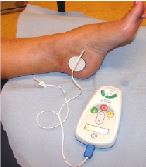Percutaneous Tibial Nerve Stimulation (PTNS)
In this Health Topic
Bladder function is regulated by a group of nerves called the sacral nerve plexus, which also controls the function of the lower end of the bowel – the rectum. PTNS involves using a thin acupuncture-like needle inserted through the skin above the ankle to stimulate these nerves through gentle electrical impulses (neurostimulation). The neurostimulation results in more functional bladder and/or rectal activity.
PTNS is an outpatient treatment for conditions affecting the bladder and the bowel such as: overactive bladder (OAB) symptoms which include urinary frequency (passing urine frequently), urgency (having to rush to the toilet to pass urine), urge incontinence (leaking urine when experiencing urgency), and nocturia (waking up at night to pass urine); non-obstructive voiding dysfunction (VD) – difficulty emptying the bladder satisfactorily; and fecal incontinence (FI) – suboptimal control over passing wind and feces. All of these conditions can affect quality of life.
If you suffer from overactive bladder symptoms, PTNS is offered when other more conservative measures have not worked for you. Conservative measures include fluid intake advice, reducing your caffeine intake, bladder retraining and pelvic floor exercise, lifestyle advice, and a trial of medications that can suppress urinary urgency. As PTNS is a relatively new treatment, we do not yet know enough about how well it works to use it routinely for all patients. PTNS can be offered when alternative treatments such as botulinum toxin or sacral nerve stimulation are either unsuitable for you or not acceptable to you.
If you suffer from fecal incontinence, PTNS may be recommended if pelvic floor muscle training and medications did not help and other interventions were not suitable or acceptable.
If you suffer from mild non-obstructive voiding dysfunction, PTNS might be useful to reduce the need for catheterization (clean intermittent self catheterization) when other interventions are not suitable. The evidence of the effectiveness of PTNS in treating OAB is stronger than its effectiveness in treating FI or VD.
While sitting in a comfortable semi-sitting position, a thin, slender acupuncture-like needle electrode will be inserted above the inner side of your ankle and a surface electrode (adhesive grounding pad) is placed over the inner side of your heel or foot to complete the circuit. It is important to insert the needle at the right location and adjust the strength of stimulation. The nurse will check this by asking questions about your sensation and observing your toe movements. The treatment session lasts 30 minutes. You will need to sit during this time and not move your leg. We advise you to bring something to distract you, such as music, a magazine or a book. You will need 12 sessions, typically one week apart, which will last about 3 months without interruption. If you miss one session, treatment can be continued. However, if you miss more than one session, a fresh count will usually need to start again. Most patients will need top-up sessions after the initial 3-month course, at variable intervals.

Research has shown that around 2 out of 3 patients who have PTNS for OAB experience significant improvement in their symptoms. However, it may take up to 8 weeks before you see any change. It is important to complete all 12 sessions before evaluating the impact of this treatment.
This treatment is usually well tolerated. 1-2% of patients have adverse effects that are reported as mild or transient and include: minor irritation, redness and/or bleeding where the needle has been inserted, or a slight aching around the ankle after treatment. You might experience short-lived tummy discomfort or toe numbness. These symptoms usually go away within a few hours. Extremely rarely hematoma (collection of blood under the skin) or nerve injury can happen.
Yes; there are alternatives, however, your specialist will discuss these further with you.
Other treatments for OAB may include:
- Botulinum toxin A injection into the bladder wall. This requires only one treatment hence it is less disruptive. It can be done under local anesthesia. There is a small risk of difficulty in passing urine afterwards, thus requiring a willingness to self catheterize. The effect usually lasts for 6-9 months and the treatment can be repeated when the effect wears off.
- Sacral nerve stimulation. This involves inserting an implant which directly stimulates the sacral nerves which control bladder and bowel function. It is a more invasive procedure requiring general anesthesia. It is usually done in two steps and requires life-long follow up. The evidence for effectiveness of this technique is stronger than that for PTNS in the long term.
- Clam cystoplasty. This operation entails expanding the bladder using a bowel segment. The aim of this is to reduce the effect of bladder muscle contractions. It is a major operation that requires life-long catheterization and follow up and is performed as a last resort.
Other treatments for voiding dysfunction include:
- Clean intermittent self catheterization. You will be taught how to do this by the nurse and will need to do this 1-4 times a day depending on your fluid intake and your bladder’s ability (or lack of it) to empty itself.
- Permanent catheterization. This can be via the urethra (water pipe) or via a small hole made into the lower part of the tummy (suprapubic catheterization). The catheter will need to be changed by the nurse every 6-12 weeks. Both catheterization options are associated with a risk of recurrent cystitis (bladder infections).
- Sacral nerve stimulation. See description above.
Other treatments for fecal incontinence include:
- Sacral nerve stimulation. See description above.
- A permanent colostomy. An operation to divert the end of the bowel to exit via a stoma, or small opening, in the tummy wall which is then covered by a bag that sticks to the skin and can be changed regularly when full.
- Other operations to reconstruct the anal sphincter.
